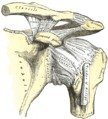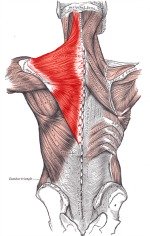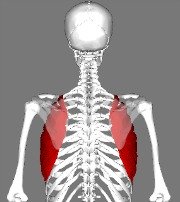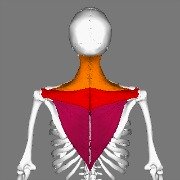Frozen Shoulder Exercises
and Treatment

Just take your time, and you'll do great.The techniques I show you are not complicated, but they must be done properly for them to work.
Follow along with the videos below and you will most likely be very pleased with the pain relief you can accomplish all by yourself. You can do it!
The 5 videos for Frozen Shoulder Exercises and Treatment are below on this page.
Go directly to any video on this page by clicking these links:
Intro,
Video 1,
Video 2,
Video 3,
Video 4,
Video 5 .
DIY Frozen Shoulder Success Story from Elle:
"Gary - I have to tell you that I have a problem with my shoulder due to being on the computer too much. I was in so much pain I thought I was going to have to take time off work. Then i found your videos on a Friday night. By the next day, I was probably 20% better. By the Monday, I was 50% better. Within two weeks, I was 100% better (it would have been sooner but once I didn't hurt all the time I got lazy lol!) THANK YOU!!!! I am going to be doing a video telling my subscribers about your fabulous videos as you truly made a huge difference in my life. I have also forwarded your videos on to so many people and my dog has also benefited. I just wanted to say thank you so much for your fabulous videos. You are appreciated. ♥ Elle"
Elle Is For Living
This short introductory video is a great place to start. It will give you a good overview.
Click directly to any pain relief video on this page:
Intro,
Video 1,
Video 2,
Video 3,
Video 4,
Video 5 .
*Please Watch This Short Video First. Thanks.
Please visit the techniques page now, if you haven't already.
On the homepage I describe…in detail…the 3 Simple Steps and the 4 Basic Facts about your body that make it possible for you to provide your own joint pain relief.
Detailed Instructions For
Frozen Shoulder Exercises
and Treatment
Click directly to any pain relief video on this page:
Intro,
Video 1,
Video 2,
Video 3,
Video 4,
Video 5 .
Here's what we're going to do:
Freeing a frozen shoulder by yourself requires that I show you how to release both the most important muscles that are causing the problem, but also that I have you work on them in an order that makes it easiest for you to release them.
This video gives a review of all the techniques we are about to do in order to free your frozen shoulder.
The most important items to understand are:

2. Your 11th Cranial Nerve (a.k.a. the spinal accessory nerve) innervates your trapezius muscle. If the nerve is compromised it can stop your trapezius from doing its job of moving your shoulder blade out of the way when you go to lift your arm and be one of the main causes of frozen shoulders.
The 11th Cranial Nerve originates in your brain stem and comes out of the hole in the bottom of your skull called your foramen (the same hole your spinal cord comes out of), but instead of going down your spinal column, is comes out in the space between your top two vertebrae. If the nerve gets pinched between your top two vertebrae it will often prevent your trapezius from working properly.
So, a main part of these frozen shoulder exercises and treatment is to make sure your 11th Cranial Nerve is free, first and foremost, before we try and do anything else.
3. Your serratus anterior muscle also plays a role in pulling your

Click directly to any pain relief video on this page:
Intro,
Video 1,
Video 2,
Video 3,
Video 4,
Video 5 .
Here's what we are going to do:
The main goal in video 2 is to free your 11th Cranial Nerve that innervates your trapezius muscle.
We are going to use the
press-pull-release technique
and the
press-hold-move technique
Starting at the base of your skull you are going to investigate and survey all the tissue in the back of your neck. You just want to press into the tissue at the base of your skull on both sides. Press into the tissue and feel for painful/tender tissue. When the tissue is painful/tender when you press on it, that means it’s tight. And tight tissue needs to be released so the bones and nerves have the space they need to function properly.
You can use your fingertips, or your thumb, to press into any tight tissue you find. Once you find some tight tissue simply do the press-pull-release technique and the press-hold-move technique until the tissue lets go.
If the tissue is stubborn and won’t let go, then feel free to move to other tight tissue and inch or two over and work on that for a while. You can work on the rest of your neck and return to the stubborn tight spots or your can go through all the videos and then return to the stubborn tight spots.
As I mention in the videos, “freeing a frozen shoulder is a bit like peeling and onion. You’ve got to go around and around a bit, getting what release you can from each area, working somewhere else for a while, but then returning to those stubborn spots.”
In my practice it usually takes about 3 rounds of all the techniques I show you in these 5 videos. Doing it yourself may take a few more rounds than that, just because I can always get more done working on someone else than I can when I work on myself, just because the patient can relax while I work on them, and because when I work on someone else I can always get in the optimal position to work on them. When I work on myself it’s not quite as easy to do that.
Notice how much this set of frozen shoulder exercises and treatment helped your shoulder.
Click directly to any pain relief video on this page:
Intro,
Video 1,
Video 2,
Video 3,
Video 4,
Video 5 .
Here's what we're going to do:
Our goal in video 3 is to free any other tight areas in your trapezius muscle that could prevent it from doing its job of moving your shoulder blade out of the way when you lift your arm.

First, put a tennis ball in a sock or a pillow case. Hang the sock over your shoulder so the ball in between the wall and your back. Now just investigate and search for tight tissue, which will be painful when you press against it with the ball using your bodyweight.
Once you find a tight spot, press the ball against it and do your bend to bend or twist in a way that makes that tissue your are pressing into move underneath the ball. This can be challenging when you have a frozen shoulder, but just do the best you can and you’ll soon get the hang of it.
Notice how much this set of frozen shoulder exercises and treatment helped your shoulder.
Click directly to any pain relief video on this page:
Intro,
Video 1,
Video 2,
Video 3,
Video 4,
Video 5 .
Here's what we're going to do:
Our goal in Video 4 is to release the second muscle that moves your shoulder blade out of the way when you lift your arm. This muscle is called you serratus anterior. This muslce attaches to the side of your ribcage and sneaks under your shoulder blade and attaches to the anterior medial edge (front edge closest to the spine) of your shoulder blade. When it flexes it pulls your shoulder blade out to the way so you can lift your arm without the humerus getting jammed into your shoulder socket.
With the arm of your frozen shoulder being supported by grabbing the front to the opposite shoulder with your hand, bend forward. You can also bend forward with the arm of your frozen shoulder hanging straight down if that position is not painful.
Now reach around with your “good” hand and arm and press your fingers into the side of your ribcage where your serratus anterior attaches. Do the press-pull-release technique and the press-hold-move technique on all the tight tissue you find along the serratus anterior.
In the same position do the same techniques on your teres muscles on the outer edge of your shoulder blade. You can do this while bent forward or stand straight up. Try both positions and see what you like.
Again, do the same techniques to release your subscapularis muscle that lies between your shoulder blade and your ribcage. You can do this while bent forward or stand straight up. Try both positions and see what you like.
Notice how much this set of frozen shoulder exercises and treatment helped your shoulder.
Click directly to any pain relief video on this page:
Intro,
Video 1,
Video 2,
Video 3,
Video 4,
Video 5 .
Here's what we're going to do:
In Video 5 we want to free some of the remaining muscles in your shoulder that may be tight and causing you to have difficulty lifting your arm.
Now that we’ve released your subscapularis and trees major and minor in the last video the upper part of your trapezius that goes along the top of your shoulder will be much more likely to let go (if it hasn’t already!). So with your opposite hand reach over to to top of your opposite shoulder and do the press-pull-release technique and press-hold-move technique
Now do the same techniques on all the muscle tissue you find on the underside of your clavicle (subclavius, pectoralis major, pectoralis minor). Any tissue that is tight will be painful/tender, but these areas are fairly easy to get at, so just stick with it and you’ll free up that entire area.
Now reach around with your good hand and do your deltoid muscles (what most people would call their “shoulder muscles’). Reach around the back, then middle, then front and release all the tissue you can. When working on the front deltoid, after it’s released, press a little deeper and work on the biceps tendon a bit, just to make sure it’s not “stuck” after you shoulder has been immobile for so long.
Notice how much this set of frozen shoulder exercises and treatment helped your shoulder.
And now, if you're not completely better, go back to video 2 and release those spots that were stubborn the first time around. Now, you may find they've already released or just need a bit more work to be set free.
Self-Assessment For
Frozen Shoulder Exercises and Treatment
How much improvement did you experience?
What techniques gave you the most relief?
Are there areas you need to revisit?
Make a mental note of what worked best, and what areas you want to revisit.
Be persistent and you'll keep improving.
Keep up the good work!
To visit the main Shoulder Joint Pain Relief page (click here)
More DIY Frozen Shoulder Exercises and Treatment Success:
"Dear Gary, I don't write to people ever but I need to write to you and express my gratitude. I have had a frozen shoulder for 2 years, with arthroscopic capsule release a year ago the surgeon said it was one of the worst cases he had had. He recommended that in not go to my physio who made things far worse. I can't write 2 years of pain and stress this has caused. I feel I tried everything. Just the other day I was in tears with the pain and searched for a solution. I found you. In two days I have had relief that I desperatly needed. I can't really thank you enough and wanted you to know how you helped me and thank you. Thank you, Ruth" - Ruth, United Kingdom
"Hi Gary, I watched your video on frozen shoulder just today and it has helped me so much! Thank you! You have no idea how much better I feel I truly appreciate all your advice. Amazing numbness in my hand is almost gone, pain is much better. Thank you so much!!!" - Cathy, United States
"Hi Gary, I wanted to THANK YOU for your very informative videos on fixing a frozen shoulder with exercises and treatment. I watched all 5 videos and followed your instructions with dramatic improvement! I am looking forward to continuing the exercises you've outlined and eventually regaining my full range of motion to my left shoulder. You were the answer my prayers, many thanks!" - Veronica, United States
This Free Pain Relief Website
By Clicking On Your Favorite Icon Below:
Add Gary Crowley to your Google Plus Circles -
Google+ (click here)
Copyright © 2011 - 2022 DiyJointPainRelief.com


